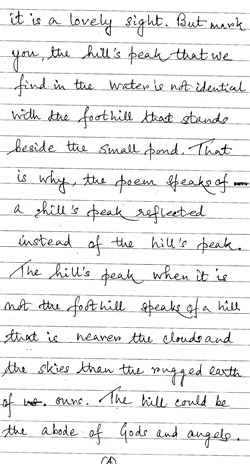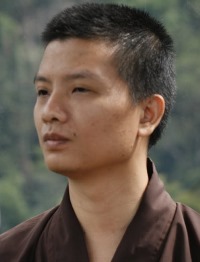Silence (13) - Mai Văn Phấn. Explication par Dr. Ramesh Chandra Mukhopadhyaya. Traduction française Dominique de Miscault
Mai Văn Phấn
Explication par Dr. Ramesh Chandra Mukhopadhyaya
Traduction française Dominique de Miscault

Long Bien ou le pont de tous les songes - Dominique de Miscault
Silence
13.
La lumière de l'aube sur ma
poitrine
je médite
Une bande
de soleil à la porte
j’entreprends
un voyage
Silencieusement je deviens sable ou pierre
inapte au temps
à l'obscurité de la nuit
Ni sec
ni acerbe
je suis
égal
fondu au
monde
Revenant après un long voyage
la ligne du
soleil est toujours là.
Explication
Il y a l'aube sans. L’aube
implique un temps sans une obscurité complète. Un peu plus tard, la lumière s’accentue
et on distingue les choses. Quelque temps plus tard, on peut sortir. Mais le
Soleil n'est pas encore au-dessus de l'horizon.
Ici, l'aube n'est pas dans le monde sans mais à l'intérieur. Le poète découvre
une lumière sur sa poitrine, c'est la lumière intérieure. Qu’est ce que la
lumière intérieure ? Le poète nous communique ses expériences, mais ne les explique
pas. Les premiers Quakers avaient l'habitude de méditer sur les textes bibliques.
Cela les a menés à l'expérience de la lumière intérieure et ils entendaient le
Saint-Esprit leur parler. Ils se souviennaient du Christ en disant : Je suis la lumière du monde. Celui qui me
suit ne marchera jamais dans l'obscurité. Oui, comme le disent les voyants,
par delà notre corps physique, il y a le corps astral. Si le corps physique est
fait de poussière ou de terre il retournera à la poussière, le corps astral,
lui, se réfère au corps associé aux cieux. Platon y a fait allusion. Le corps
astral est aussi, associé aux chakras. Il semble que le poète médite sur le
premier chakra. Oui, la méditation sur les chakras est impliquée dans
l'exhortation du Seigneur Bouddha quand il parle de kayagata sati ou de
conscience enraciné dans le corps. Le premier chakra est situé à la base de la
colonne vertébrale, dans la région pelvienne. Sa couleur est marron-rougeâtre.
La lumière est soumise à quelque chose comme l'aube vécue par le poète. La
lumière de la conscience pure ici, semble être submergée par la densité de la
matière ou de l'obscurité. Mais néanmoins, une bande de soleil est la porte du
voyage. Le voyage n'est pas un voyage. Il rappelle la célèbre chanson des Beatles :
Sans sortir par la porte
Je peux tout savoir sur Terre
Sans regarder par la fenêtre
Je pourrais connaître les voies du paradis
Suivons le poète dans son voyage. Le voyage n'est ni dans l'espace
ni horizontal, il est vertical et passe d'un plan de conscience à un autre. Le
poète devient silencieusementsable ou pierre.
Commencement du temps
Obscurité immaculée de la nuit
Où sont le sable et les
pierres.
Sont-ils là-bas ? Sont-ils dans notre esprit ? Le rocher et
la pierre peuvent faire allusion au sable et au jardin de pierre japonais. Il
parle de i haku no bi ou de la beauté
de l'espace vide ou du sunya de Nagarjuna. Les jardins-paysages secs ou
karesunsui en Japonais, signifie - bon pour la contemplation. Le poète s'échappe
à lui-même en devenant pierre ou grain de sable. Ainsi, il devient une partie
du jardin sec ou rien ou sunya. Il n'est plus sensible aux intempéries et aux variations
météorologiques. La pierre rappele une lanterne en pierre qui représente la
lumière de Bouddha qui dissipe l'obscurité et l'ignorance. Oui, l'obscurité
immaculée représente l'obscurité de l'ignorance. Ou bien, l'obscurité est la
réalité inconnue et inconnaissable qui se cache derrière le spectacle des
choses. La lumière se réfère au monde perceptible. L'obscurité signifie
l'au-delà et l'absolu que nos esprits ne peuvent saisir.
Ainsi, à cause d’une bande de lumière, le poète a commencé son
voyage et maintenant il est face à face avec le sunya
et l'obscurité absolue, seulement pour se débarrasser de sa différence par
rapport aux choses du monde. Les différences constituent le monde de
l'apparence. Le poète se débarrasse de sa différence par rapport aux autres
choses du monde
Ni sec
ni acerbe
je suis
égal
confondu au
monde
Revenant après un long voyage
la ligne du
soleil est toujours là.
La contemplation du poète ne dure pas longtemps. Mais ses
expériences l’ont plongé profondément en lui-même. La bande de lumière du
soleil est toujours là.
Nous espérons que chaque fois que le poète se mettra à la porte de
la lumière du soleil, il nous informera de ses expériences qui sont tout à fait
différentes des nôtres. Nous sommes enfermés dans la cage du temps et de l’espace
singulier. Mais il pourrait y avoir beaucoup d’autres temps et d'espace, mais
aussi un au-delà.
Dominique de Miscault:
Artiste Plasticienne. De plages en pages qui se tournent. C’était hier, de 1967 à 1980, mais aussi avant hier, dominiquedemiscault.com. puis de 1981 à 1992. Et encore de 1992 à 2012 bien au delà des frontières. Aujourd’hui, la plage est blanche sous le bleu du soleil.
(http://www.dominiquedemiscault.fr)
Silence (13) by Mai Văn Phấn
Explicated by Dr. Ramesh Chandra Mukhopadhyaya
Translated into Vietnamese by Phạm Minh Đăng

Thủ bút của Ts. Ramesh Chandra Mukhopadhyaya
Silence
13.
Dawn’s light is thrown across my chest
When I begin to meditate
One strip of sunlight is the gate
To begin a journey
I silently become sand or a stone
Inane in weather
And night’s pristine darkness
No longer dry
No longer sharp
I am equal to
And mixing into the world
As I return after a long journey
That strip of sunlight is still there.
(Translated from Vietnamese by Nhat-Lang Le & Susan Blanshard)
Explication
There is the dawn without. Dawn implies that astronomical time when it is no more complete darkness. A little later light becomes more pronounced and things are distinguishable with bare eyes. Alittle later still one can move outdoor. But the Sun is not as yet above the horizon.
But here the dawn is not in the world without but within. The poet finds a light thrown across his chest. This is inner light. Well what could be the inner light? The poet communicates his experiences here. But he is not supposed to explain them. The first Quakers used to meditate on the words in the Bible. Soon that would lead to the experience of the inner light and they would hear the Holy Ghost talking to them. They remember Christ saying---I am the light of the world. Whoever follows me will never walk in darkness. Yes as the seers say, below this physical body, there is the astral body. While the physical body is made of dust or earth and will return to dust, the astral body refers to the body associated with the planetary heavens. Plato alluded to it. And the astral body is associated with the chakras. It seems that the poet meditates on the first chakra. Yes meditation on chakras is implied in Lord Buddha’s exhortation when he speaks of kayagata sati or mindfulness rooted in the body. The first chakra is located at the base of spine, in the pelvic region. The colour is here reddish brown. The light is here subdued something like that of the dawn experienced by the poet. The light of pure consciousness here seems to be subdued by the denseness of matter or darkness. But nevertheless one strip of sunlight is the gate to begin a journey. The journey is no journey. It puts in the mind of the readers the famous song of the Beatles.
Without going out of door
I can know all things on Earth
Without looking out of the window
I could know the ways of heaven
And let us follow the poet in his journey. The journey is not in the space and horizontal. It is vertical from one plane of consciousness to another plane.
The poet silently becomes sand or a stone.
Inane in weather
And night’s pristine darkness
Where are the sands and stones. Are they out there? Or else may be they are inside our mind. Rock and stone may allude to sand and stone garden Japanese style. It speaks of yo haku no bi or the beauty of blank space or sunya of Nagarjuna. The dry landscape gardens imply karesunsui in Japanese, meaning – good for contemplation. The poet forgets his own self and becomes a stone or a grain of sand. Thus he becomes a part of the dry landscape garden or nihil or sunya. He is not sensitive to weather and changes in weather. Stone might remind one of stone lanterns that. Stands for the light of Buddha that dispels the darkness of ignorance. Yes the pristine darkness represents the darkness of ignorance. Or else darkness is the unknown and unknowable reality lurking behind the show of things. Light refers to the perceptible world. Darkness signifies the beyond and the absolute which our minds cannot possibly grasp.
So through a strip of light the poet began his journey and now he is face to face with the sunya and the absolute or pristine darkness only to get rid of his difference from other things of the world. Differences constitute the world of appearance. The poet gets rid of his difference from other things in the world.
No longer dry
No longer sharp
I am equal to
And mixing into the world
The contemplation of the poet does not continue for long. But his occult experiences have sunk deep in his mind. The strip of sunlight is still there.
So we hope that whenever the poet sets out through the gate of sunlight he will inform us about his experiences which are quite different from ours. We are pent up in the cage of a particular time and space. But there could be many more time and space. And also there could be a beyond.
Tĩnh lặng (13) của Mai Văn Phấn
Ramesh Chandra Mukhopadhyaya chú giải
Phạm Minh Đăng dịch sang tiếng Việt

Dịch giả Phạm Minh Đăng
Tĩnh lặng
13.
Bình minh vắt ngang ngực
Lúc tôi bắt đầu hành thiền
Dải nắng ấy là cửa ngõ
Khởi đầu cuộc lên đường
Tôi lặng yên làm cát đá
Ngây ngô trong mưa nắng
Bóng đêm trinh bạch
Không khô cứng
Không còn sắc nhọn
Tôi bình đẳng
Hòa trong thế giới
Đi xa trở về
Dải nắng ấy vẫn còn chỗ cũ.
Chú giải
Bình minh bên ngoài kia. Bình minh chỉ khoảng thời gian thiên văn khi không còn bóng tối phủ trọn nữa. Một chút ánh sáng rồi dần rỡ ràng và sự vật rõ nét hình trong mắt. Một chút nữa thôi, người ta có thể bước ra khỏi cửa. Lúc mặt trời vẫn chưa hiện phía chân trời.
Nhưng nơi đây bình mình không phải bên ngoài mà bên trong thế giới. Nhà thơ thấy ánh sáng vắt ngang ngực. Đó là ánh sáng nội tại. Mà cái gì có thể là ánh sáng nội tại đó? Nhà thơ biểu lộ giao tiếp kinh nghiệm của mình tại đây. Nhưng ông không định giải thích. Những tín đồ phái giáo hữu đầu tiên thường quán tưởng những lời trong Kinh Thánh. Sự quán tưởng đó nhanh chóng đưa tới trải nghiệm ánh sáng nội tại và họ nghe được lời Thiên Chúa. Họ nhớ lời Chúa phán – “Ta là sự sáng của thế gian. Người nào theo ta, chẳng đi trong nơi tối tăm, nhưng có ánh sáng của sự sống*”. Đúng như các nhà tiên tri nói, dưới thể hồng trần (physical body), có thể cảm dục** (astral body). Nếu thể hồng trần được sinh ra từ cát bụi và sẽ trở về cùng cát bụi, thể cảm dục gắn liền với các thiên giới tinh cầu. Plato gợi nhắc điều này. Và thể cảm dục gắn kết với các luân xa. Dường như nhà thơ quán tưởng về luân xa thứ nhất. Việc quán tưởng về các luân xa được ám gợi qua các lời dạy của Đức Phật khi ngài nói về Niệm Thân (kayagata sati) hay chánh niệm bắt rễ từ cơ thể. Luân xa thứ nhất ở đốt dưới cùng cột sống, vùng xương chậu. Có màu nâu đỏ. Ánh sáng nơi này sắc dịu như sắc bình minh trong trải nghiệm của nhà thơ. Ánh sáng của ý thức thuần túy ở đây lại như gợi đến độ đậm đặc của vấn đề hay bóng tối. Dù vậy, một dải nắng là cửa ngõ khởi đầu cuộc lên đường. Một hành trình không hành trình. Nó khiến độc giả nhớ tới một bài hát nổi tiếng của the Beatles:
Chẳng bước ra khỏi cửa
Tôi biết mọi điều trên Trái đất
Chẳng nhìn ra cửa sổ
Tôi biết những đường tới Thiên đường***
Và ta hãy bước theo nhà thơ trong cuộc hành trình này. Hành trình không xảy ra trong các định vị không gian theo chiều ngang. Một hành trình dọc từ bề mặt này của ý thức sang một bề mặt khác.
Nhà thơ lặng yên làm cát đá
Ngây ngô trong mưa nắng
Bóng đêm trinh bạch
Cát và đá ở nơi nào? Chúng ở ngoài kia? Hay chăng chúng bên trong tâm trí ta. Đá có thể làm liên tưởng tới cát và vườn đá [cảnh] kiểu Nhật Bản. Nó thể hiện vẻ đẹp của khoảng trống (yohaku no bi) hoặc khái niệm Hư trống (shunya) của Long Thọ. Các vườn cảnh khô, karesunsui trong tiếng Nhật nghĩa là nơi thích hợp cho việc chiêm ngắm. Nhà thơ quên lãng tự ngã và trở thành một hòn đá, một hạt cát. Khi đó, ông đã trở thành một phần của vườn cảnh khô hay sự hư trống. Ông không nhạy cảm với thời tiết và những biến đổi của thời tiết. Đá cũng có thể gây liên tưởng tới một ngọn đèn đá biểu tượng cho ánh sáng của Phật xua tan bóng tối vô minh. Và bóng đêm trinh bạch cũng là bóng đêm của sự vô minh. Hay bóng đêm là một hiện thực chưa biết và không thể biết đằng sau sự bày ra của vật. Ánh sáng là một thế giới có thể nhận thức được. Bóng đêm hàm ý sự siêu vượt hoặc cái tuyệt đối mà tâm trí ta không thể nắm bắt.
Vậy nhờ một dải ánh sáng, nhà thơ bắt đầu cuộc hành trình của mình và hiện tại đối mặt với hư trống và bóng đêm đen đặc hay trinh bạch chỉ để từ bỏ sự khác biệt của ông với ngoại vật trên thế giới. Sự khác biệt làm thành thế giới ngoại hiện. Nhà thơ từ bỏ sự khác biệt của ông với ngoại vật trong thế giới.
Không khô cứng
Không còn sắc nhọn
Tôi bình đẳng
Hòa trong thế giới
Sự chiêm ngắm của nhà thơ diễn ra không lâu. Nhưng kinh nghiệm huyền bí đã gắn sâu vào tâm trí ông. Dải nắng vẫn còn đó.
Chúng ta hy vọng bất cứ khi nào nhà thơ băng ngang cổng nắng, ông sẽ báo ta hay các trải nghiệm của ông, điều không hẳn giống với kinh nghiệm của ta. Chúng ta mắc kẹt trong cái lồng giam không gian và thời gian cụ thể. Nhưng còn có nhiều hơn không gian và thời gian. Và cũng có thể một nơi chốn siêu vượt nữa.
__________
* Dẫn theo Tân Ước, Giăng 8:12 (Người dịch)
*** Phỏng dịch một phần trong bài “The inner light” do George Harrison (The Beatles) sáng tác.
Tĩnh lặng - Silence (1)
Tĩnh lặng - Silence (2)
Tĩnh lặng - Silence (3)
Tĩnh lặng - Silence (4)
Tĩnh lặng - Silence (5)
Tĩnh lặng - Silence (6)
Tĩnh lặng - Silence (7)
Tĩnh lặng - Silence (8)
Tĩnh lặng - Silence (9)
Tĩnh lặng - Silence (10)
Tĩnh lặng - Silence (11)
Tĩnh lặng - Silence (12)
Biography of Dr. Ramesh Chandra Mukhopadhyaya
Address: 6/ 1 Amrita Lal Nath lane P.0. Belur Math Dist Howrah West Bengal India Pin code711202. Date of Birth 11 02 1947. Education M.A [ triple] M Phil Ph D Sutrapitaka tirtha plus degree in homeopathy. He remains a retired teacher of B.B. College, Asansol, India. He has published books in different academic fields including religion, sociology, literature, economics, politics and so on. Most of his books have been written in vernacular i.e. Bengali. Was awarded gold medal by the University of Calcutta for studies in modern Bengali drama.
Tiểu sử Tiến sĩ Ramesh Chandra Mukhopadhyaya
Địa chỉ: 6/ 1 đường Amrita Lal Nath hòm thư Belur Math Dist Howrah Tây Bengal Ấn Độ mã số 711202. Ngày sinh: 11 02 1947. Thạc sĩ văn chương, thạc sĩ triết học, tiến sĩ triết học [bộ ba] cùng với Bằng y học về phép chữa vi lượng đồng cân. Ông còn là một giảng viên đã nghỉ hưu của Trường đại học B.B, Asansol, Ấn Độ. Ông đã có những cuốn sách được xuất bản về nhiều lĩnh vực học thuật bao gồm tôn giáo, xã hội học, văn học, kinh tế, chính trị v.v. Hầu hết sách của ông đã được viết bằng tiếng bản địa là tiếng Bengal. Ông đã được tặng thưởng huy chương vàng của Trường đại học Calcutta về các nghiên cứu nghệ thuật sân khấu Bengal hiện đại.

"Lá rơi" - Tác phẩm của Nhiếp ảnh gia Nguyễn Đức Cung (Hoa Kỳ)